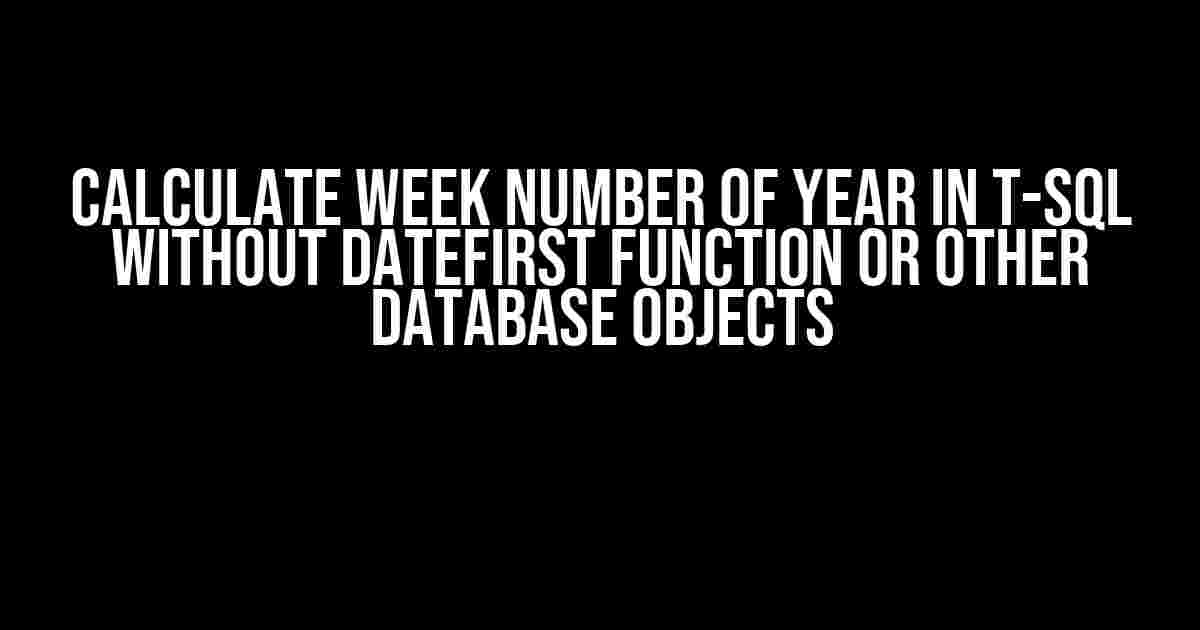Are you tired of relying on the DATEFIRST function or other database objects to calculate the week number of the year in T-SQL? Well, you’re in luck because we’ve got a solution that’s pure T-SQL magic! In this article, we’ll show you how to calculate the week number of the year using only T-SQL, without relying on any external functions or objects. So, buckle up and let’s dive in!
Understanding the Challenge
Calculating the week number of the year can be a bit tricky, especially when you’re working with dates that fall on the boundary of a week. The DATEFIRST function is usually the go-to solution for this problem, but what if you don’t have access to it or prefer not to use it? That’s where our T-SQL solution comes in.
The Problem with DATEFIRST
The DATEFIRST function is a built-in function in T-SQL that returns the first day of the week as an integer. However, it has some limitations. For example, it only returns the first day of the week based on the language setting of the server, which can lead to inconsistent results. Moreover, it requires a specific date format to work correctly, which can be a hassle to manage.
The Solution
So, how do we calculate the week number of the year without using the DATEFIRST function? The answer lies in a clever combination of date arithmetic and logic. Here’s the solution:
DECLARE @date DATE = '2022-07-25'; -- Input date
DECLARE @firstDayOfYear DATE = DATEFROMPARTS(YEAR(@date), 1, 1);
DECLARE @firstDayOfWeek DATE = DATEADD(DAY, 7 - DATEPART(WEEKDAY, @firstDayOfYear), @firstDayOfYear);
DECLARE @weekNumber INT = CEILING((DATEDIFF(DAY, @firstDayOfWeek, @date) + 1) / 7.0);
SELECT @weekNumber AS WeekNumber;
How it Works
Let’s break down the solution step by step:
- We declare the input date as a variable
@date. - We calculate the first day of the year using the
DATEFROMPARTSfunction, which takes the year, month, and day as input. - We calculate the first day of the week by adding the difference between the first day of the year and the first day of the week to the first day of the year. This ensures that we get the correct first day of the week, regardless of the language setting.
- We calculate the week number by using the
DATEDIFFfunction to get the number of days between the first day of the week and the input date, and then dividing the result by 7. We add 1 to the result to account for the first day of the week. - Finally, we use the
CEILINGfunction to round up the result to the nearest whole number, which gives us the correct week number.
Example Results
Let’s test the solution with some example dates:
| Input Date | Week Number |
|---|---|
| 2022-01-01 | 1 |
| 2022-01-08 | 2 |
| 2022-02-14 | 7 |
| 2022-07-25 | 30 |
| 2022-12-31 | 52 |
As you can see, the solution correctly calculates the week number for each input date.
Conclusion
In this article, we’ve shown you a pure T-SQL solution for calculating the week number of the year without relying on the DATEFIRST function or other database objects. This solution is robust, efficient, and easy to implement. With this solution, you can confidently calculate the week number of any date in T-SQL, without worrying about language settings or date formats.
So, the next time you need to calculate the week number of the year in T-SQL, remember this solution and impress your colleagues with your T-SQL magic!
Final Tip
If you’re working with a large dataset, consider creating a user-defined function (UDF) that encapsulates this solution. This will make it easy to reuse the solution and improve performance.
CREATE FUNCTIONdbo.GetWeekNumber (@date DATE)
RETURNS INT
AS
BEGIN
DECLARE @firstDayOfYear DATE = DATEFROMPARTS(YEAR(@date), 1, 1);
DECLARE @firstDayOfWeek DATE = DATEADD(DAY, 7 - DATEPART(WEEKDAY, @firstDayOfYear), @firstDayOfYear);
DECLARE @weekNumber INT = CEILING((DATEDIFF(DAY, @firstDayOfWeek, @date) + 1) / 7.0);
RETURN @weekNumber;
END;
With this UDF, you can easily calculate the week number for any date in your dataset, making your life as a T-SQL developer much easier!
Frequently Asked Question
Get ready to boost your T-SQL skills and master the art of calculating week numbers without relying on the DATEFIRST function or other database objects!
Q1: How can I calculate the week number of a date without using the DATEFIRST function?
You can use the following formula: `SET @WeekNumber = (DATEPART(wk, @Date) + @@DATEFIRST – 2) % 7 + 1`. This formula takes into account the current language setting and calculates the week number accordingly.
Q2: What is the significance of the ‘-2’ in the formula?
The `-2` is used to adjust for the fact that `DATEPART(wk, @Date)` returns a value between 1 and 7, whereas we want the week number to start from Sunday (1) and end on Saturday (7). By subtracting 2, we effectively shift the week number calculation to start from Sunday.
Q3: How does the formula handle dates that fall on the first week of the year?
The formula takes care of dates that fall on the first week of the year by using the modulo operator (`%`). This ensures that week numbers wrap around to 1 when the calculation exceeds 7. This means that dates in the first week of the year will correctly return a week number of 1.
Q4: Can I use this formula for dates in any year?
Yes! This formula is year-agnostic and will work correctly for dates in any year. The `DATEPART(wk, @Date)` function takes into account the year and returns the correct week number based on the date.
Q5: Are there any performance considerations when using this formula?
This formula is computationally efficient and should not have a significant impact on performance. However, if you’re working with large datasets, it’s always a good idea to test and optimize your queries to ensure the best possible performance.

